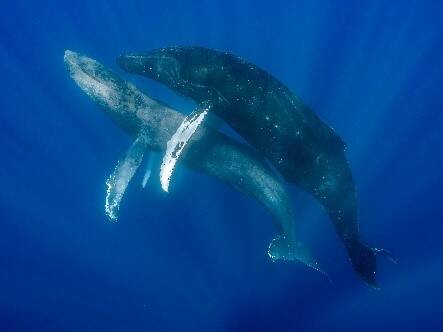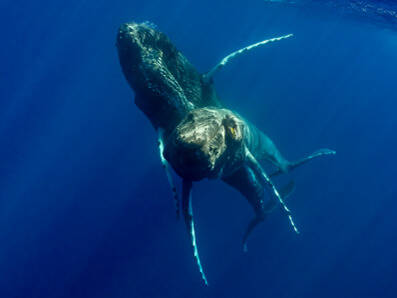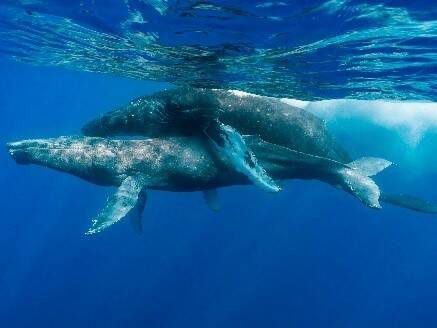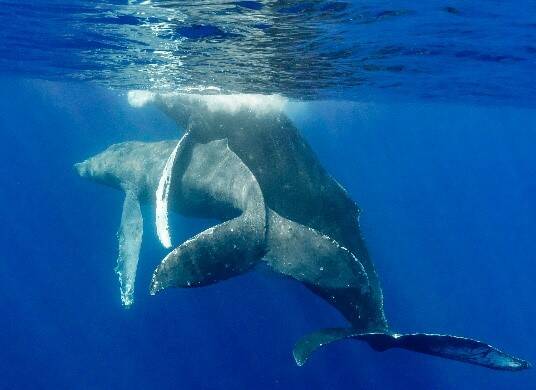Never-before-seen act documented in humpback whales off Hawaii coast
When Brandi Romano and Lyle Krannichfeld scanned the crystal blue waters off the Hawaii coast and two humpback whales came into view, they killed the engine of their boat, retrieved their cameras and started snapping away.
The Maui photographers didn’t expect that what they were about to encounter that morning in January 2022 was something that had never been observed in the species before.
The whales swam within about 10 to 15 feet of the vessel, one of them appearing to closely follow the other. Romano and Krannichfeld lowered their cameras into the water, noticing that one of the whales had an unusual brown discoloration on its body. The creatures slowly circled the boat several times, and when the photographers got a closer look, they realized the discoloration was due to an ectoparasite known as whale lice. The animal was covered in it, and seemed to be struggling as it tried to flee from the other whale. But to no avail.
The photographers looked on as the whale pinned the other one in place with its pectoral fins and appeared to begin mating with it. The act lasted about 30 minutes, and when it was over, the healthy whale dove off and did not return. The first one lingered near the surface of the water for a few minutes before also plunging into the depths of the sea.
Romano and Krannichfeld weren’t sure what they had just witnessed. Thousands of humpback whales migrate from Alaska to Hawaii every winter to kickstart the breeding season, but this act seemed to warrant further investigation. Eager to learn more, they shared their photos with Stephanie Stack, a biologist at the Pacific Whale Foundation, a whale research nonprofit also based in Maui. As she looked at the photographs, she noticed something unusual: both of the individuals involved were male, and that this was a display of non-conceptive sexual behavior not seen in humpback whales before.
“Despite decades of research on humpback whales around the world, reports of penis extrusion by males are relatively rare, and copulation in humpback whales has not yet been documented,” Stack wrote in her resulting study, which was published earlier this month in the Marine Mammal Science journal. “This is the first report of penetration by a humpback whale, and the first report of sexual activity between two male humpback whales.”
The trio’s discovery has made the rounds online, and scientists are still trying to unpack what it could mean for future research of cetacean behavior.
In the Bay Area, Bill Keener, a research biologist for the Marine Mammal Center, has been closely analyzing the sex lives of harbor porpoises under the Golden Gate Bridge since the early aughts. But to learn about this unique interaction in another cetacean species — let alone one as large as a humpback whale, about 12 times the size of a harbor porpoise — was astonishing.
“In the animal kingdom, male-on-male sexual activity is a relatively common behavior to document, but as cetacean researchers, we simply had not seen this type of activity with humpback whales before,” Keener said in an email.
Behavior of this nature has been observed in several other species, such as walruses, gray seals, Amazon river dolphins, bottlenose dolphins and killer whales. The purpose of the interactions can range from “learning or practicing reproductive behaviors, establishing or reinforcing dominance relationships, forming social alliances, and/or reduction in social tension,” according to the study.
“It took our team several years to document similar behaviors with harbor porpoises after we first reported similar same sex activity from drone imagery taken off the Shetland Islands,” Keener said. “This specific event with humpbacks off the Hawaii coast opens a new window and research opportunity into their mating habits.”
Photographs of the whales uploaded to Happywhale, an online database for whale sightings, determined the injured whale was No. PWF-NP_5016, an adult male first observed by the Pacific Whale Foundation in 2020. The healthy whale was identified as No. PWF-NP_3754, an adult male initially spotted in 1993. Information on the exact age of both whales was not included in the study.
Stack noted that “animal behavior is shaped by a complex interaction of internal drivers and external stimuli, making it difficult for researchers to assign motive to an observed behavior.” However, she speculated that the healthy whale may have been mistakenly trying to mate with its counterpart, was trying to reinforce a bond with its ailing peer, or expressing its dominance over a weak competitor with the goal of gaining access to a resource such as food or a mate. The injured whale appeared to have sustained a blow to its jaw consistent with trauma sustained from a ship strike, which can cause an animal to suffer for a long period of time and decline in health, possibly explaining the lice and reduced mobility that prevented it from escaping.
Still, the interaction is atypical of non-reproductive sexual behavior in whales, said Jackson Ham, a Ph.D. candidate at the Canadian Centre for Behavioural Neuroscience, who recently co-authored a chapter on non-conceptive sexual behavior in the book “Sex in Cetaceans.”
“In many species, this behavior is playful,” he told SFGATE in an email. “However, in most observations to date, the behavior is conducted between healthy individuals, making this a unique finding.”
At least one other similar incident was recorded off the coast of Hawaii in 1998, when a humpback whale extruded its penis next to the floating body of another whale that had died in a competitive group shortly before. However, documenting and gathering examples of such behavior can prove challenging and is likely underreported due to a number of obstacles in observing humpback whales.
“Not surprisingly, humpback whales live in remote locations of the ocean and so are often hard to access,” Ham said. “In many cases, and during many times of the year, they live far away from coastlines, so accessing them for observation can be difficult. Further complicating our observations of these whales [is that] in most cases, their behavior occurs deep underwater, which obstructs our view from the surface while either on boats or in aircraft.”
Ham said Romano and Krannichfeld had “a unique opportunity” to capture the interaction in great detail, perhaps in part due to the whale’s injury that drew it to approach the boat for cover from the other animal. Although seemingly gruesome, the observations reported by the photographers and confirmed by Stack are “exciting and rare,” he said, and occurred as a result of “a perfect storm” of conditions. He suspects the behavior is likely occurring more regularly than scientists previously knew — they just haven’t been able to see it.
“The water appears to be calm giving them good visibility, the light was shining through the water column illuminating the behavior, and finally, the whales approached the boat giving the observers a close view of this intimate behavior,” Ham said.
This discovery proves significant for researchers because it exposes the importance of collaborating with citizen scientists to gain a better understanding of the ocean ecosystem, Stack said in the study.
Ham noted that because some humpback whale populations are listed as endangered, it’s even more important to understand their mating and social behavior from a conservation standpoint.
“Looking at the big picture, this report adds to the growing literature that suggests that non-reproductive sexual behavior is widespread in cetaceans,” he said. “Perhaps this is a behavior that evolved long ago and is present in many, if not most, cetacean species.”





